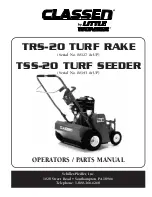
42
English
capacity will therefore be sent to the vibrating harrows, that capacity also depends on the
force required to level the soil, which in turn depends on the factors mentioned above. The
higher the driving speed, the higher the amount of soil that needs to be raked per movement
of the harrow, and hence the higher the required capacity. The driving speed must therefore
also be adjusted to the conditions of the soil.
6. Stones in the soil
Explanation: in rocky soil, it is impossible to remove all of the obstacles in advance. You will
simply have to assume that the harrows will come in contact with stone. Stones can damage
the harrows on impact. A low driving speed will reduce the amount of energy on impact and
increase the time the operator has available to react. From a safety point of view it is therefore
recommended to reduce speed in rocky or stone-rich areas.
• Be alert! When hitting a stone or hard object - stop the machine immediately and remove the
object before continuing.
• If stones or other objects surface as a result of the raking movement, stop immediately and
remove them before continuing.
• Should you notice that the machine seems to dig itself in when the vibrating harrows are too
deep into the soil, adjust the height of the vibrating harrows.
• When laying a sloping terrain, beware that when reaching the top, the front rollers will come
off from the surface, causing the vibrating harrows to dig deeper into the soil and thus
levelling the terrain. This can be avoided by adjusting the depth of the harrows when reaching
the top, or by tilting the machine slightly backwards to create a more shallow grip of the
vibrating harrows on the soil.
• The speed of the vibrating harrows and the driving speed can be controlled by adjusting
the engine’s rotational speed (between 3200 and 2700 RPM) with the thrust level on the
handlebar.
9.6.4 Sowing, raking and pressing
Once the surface has been crumbled and levelled out, it is ready for sowing.
Sowing:
The seed reservoir is placed in the machine (read § ) and will scatter the seeds according to the
set flow rate (read § ).
The guide plate, along which the seeds slide down, comes to about 10 cm above the ground
providing a low free fall height to minimise the effect of the wind on the seed distribution. The
scatter zone is located between the front roller and the vibrating harrow.
Covering the grass seed:
As no further actual tillage is required during the seeding process, the vibrating harrow does
not need to be set deep. The function of the vibrating harrow is now to evenly distribute the
scattered seed over the working width so that the sowing lines are broken up.
Summary of Contents for GZC 1000
Page 1: ...GZC 750 GZC 1000 M A N U A L...
Page 86: ...86 English...
Page 91: ...91 English...
Page 92: ......


































